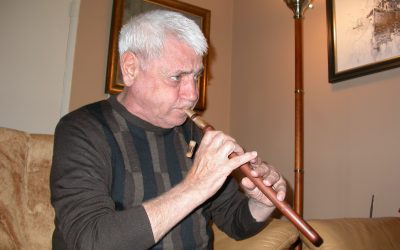Mohammad Nejad, a Persian-born master multi-instrumentalist, was born to a musical family in Tehran, Iran. As a young child, Persian classical music was passed down to him from his father. In Tehran he attended a special high school for musicians, later graduating from Fine Arts Academy in 1976, and in…
In May of 2001, Joe Potzernitz passed away. He was a master artist who contributed so much to the cultural landscape of California. He is missed by the many who enjoyed and benefited from his work. One of the primary distinguishing features of California saddlery is the decorative floral carving…
Houman Pourmehdi is a master percussionist, well known for his diverse abilities as a musician, composer, and multi-instrumentalist, performing and recording in numerous ensembles and at a variety of venues. He was introduced to Persian music by his father, and received his first Tonbak at the age of three from…
The Croatian bagpipe or gajde is a common instrument in Croatian traditional music in Hungary. It is an ancient instrument with a large repertoire and several distinctive styles of playing, determined largely by the geographical/regional location of the musician. The instrument is constructed by various parts, the bag, which is…
Gardena-based master kutuu player Katsuko Teruya Arakawa served as a master artist in ACTA’s Apprenticeship Program in 2008 with apprentice Pamela Joy Afuso of Los Angeles. The Okinawan kutuu, more commonly known elsewhere in Japan as the koto, is a thirteen-stringed Paulownia wood zither played by…
Katsuko Teruya began studying kutuu (Okinawan koto) at the age of 18 under Nae Kochi the Senior Headmaster of the Naha Koyokai in Japan. After earning a junior teaching certificate in 1954, Katsuko moved Hawai’i but continued to study with Nae Kochi until earning the Senior Teaching Certificate in 1965. …
Djivan Gasparyan (1928-2021) was an Armenian musician and composer based in Sherman Oaks, CA. He played the duduk, a double reed woodwind instrument related to the orchestral oboe. Born in Solak, Armenia to parents from Mush, Gasparyan started to play duduk when he was six. In 1948 he became a…
Sometimes when a people survive the greatest of tragedies, art and culture is the first thing they turn to in order to continue. Although 90 percent of all Cambodian classical artists perished between 1975 and 1979 after the fall of the Khmer Rouge, those who did survive wandered out from…
When Hmong families are joined by marriage, a complicated tradition of rituals are observed that resolves any existing problems between the clans and sets new rules for the future. The ritual defines relationships between people and is important in maintaining harmony in Hmong society. It is just as important in…
Crispulo Atillo is a Grandmaster of eskrima, a non-aggressive, weapons-based martial art rooted in Filipino history and culture. Great Grandmaster Atillo began studying eskrima as a teenager with his father and with Great Grandmaster Teodoro Saavedra. He was a master artist in ACTA’s Apprenticeship Program in 2006 with apprentice, Red Dagum. *** From…


